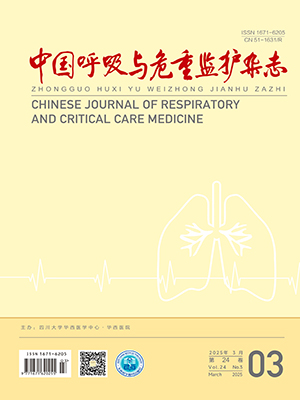Objective To evaluate the therapeutic effects of different airway management strategies early used for patients after abdominal surgery in general anesthesia. Methods According to gender, age,and operation location,200 patients after abdominal surgery in general anesthesia were randomly assigned to four groups, ie. a conventional treatment group ( Group A) , an incentive spirometry ( IS) therapy group ( Group B) , an aerosol inhalation group ( Group C) , a combination of inhalation and IS therapy group ( Group D) . Inhalation drugs included Budesonide, Terbutaline, and Ambroxol. The index of pulmonary function test ( FVC, FEV1 , PEF) and arterial blood gases analysis ( ABG) were measured, and the effect of secretions clearance and the improvement of respiratory symptoms were evaluated at 0.5 h,24 h, 48 h after extubation.
Intratracheal intubation of the patients after leaving ICUwas followed up. Results FVC, FEV1 , PEF, ABG,sputumvolume, the effect of secretions clearance, clinical efficacy, and intratracheal intubation rate in group B, C and D were improved more significantly than those in group A. And the therapeutic effect was best in group D ( P lt;0. 05) . The secretions clearance was improved more better in group C and D, especially in those high-risk patients with advanced age, smoking history, and pulmonary cormobidities ( P lt; 0. 05) .Conclusions The combined use of IS training and inhalation therapy can improve airway secretions clearance and pulmonary function particularly for those patients after abdominal surgery in general anesthesia, especially for those high-risk patients.
Citation:
ZHOU Yongfang,JINXiaodong,KANGYan,HUZhi,ZHONGMingxing. Clinical Significance of Combined Use of Incentive Spirometry and Aerosol Inhalation in Patients after Abdominal Surgery in General Anesthesia. Chinese Journal of Respiratory and Critical Care Medicine, 2010, 9(5): 512-516. doi:
Copy
Copyright © the editorial department of Chinese Journal of Respiratory and Critical Care Medicine of West China Medical Publisher. All rights reserved
| 1. |
Kocabas A, Kara K, Ozgur G, et al. Value of preoperative spirometry to predict postoperative pulmonary complications. Respir Med,1996, 90: 25 -33 .
|
| 2. |
杜斌. 腹部手术对呼吸功能的影响. 中国实用外科杂志, 2004 ,24: 136-138 .
|
| 3. |
朱蕾, 樊嘉. 围手术期的呼吸生理变化和肺部常见并发症. 中国呼吸与危重监护杂志, 2006, 5: 410-412.
|
| 4. |
王昆, 张晓华. 腹部手术前后血气变化60 例分析. 实用医学杂志, 2003, 19: 750-751 .
|
| 5. |
陈亚光, 方力, 曹文声. 老年人腹部手术前后血液气体、酸碱平衡的变化. 衡阳医学院学报, 1999 , 12 : 178-180.
|
| 6. |
廖培娇, 许红璐, 雷阳阳, 等. 不同雾化吸入方案对气管内麻醉下上腹部手术后气道炎症反应的影响. 中华普通外科学文献,2007, 1: 118 -121.
|
| 7. |
李德珍. 沐舒坦雾化治疗全麻手术后患者咳痰困难的效果观察. 南方护理学报, 2005, 12: 57-58 .
|
| 8. |
李洁, 张煜, 詹庆元. 人工气道的湿化. 中国呼吸与危重监护杂志, 2006, 5: 473 -477.
|
| 9. |
孙晓辉, 何庆军, 梁国鹏, 等. 肺扩张治疗研究进展. 中国呼吸与危重监护杂志, 2008, 7: 95-98.
|
| 10. |
Robertl, Wilkins, Jamesk, et al. Egan’s Fundamentals of Respiratory Care, Nighth Edition, 2008 , 906-909.
|
| 11. |
葛春林, 王晓松, 孙树, 等. 预防腹部手术后肺部并发症的临床研究. 中国实用外科杂志, 2004, 24: 148-150.
|
| 12. |
Overend TJ, Anderson CM, Lucy SD, et al. The effect of incentive spirometry on postoperative pulmonary complications: a systematic review. Chest, 2001, 120: 971-978 .
|
| 13. |
Ferguson MK. Preoperative assessment of pulmonary risk. Chest,1999, 115 ( 5 Suppl) : 58S-63S.
|
| 14. |
Doyle RL. Assessing and modifying the risk of postoperative pulmonary complications. Chest, 1999, 115( 5 Suppl) : 77S-81S.
|
| 15. |
Mitchell CK, Somger SH, Pfeifer MP, et al. Mutivariate analysis of factors associated pulmonary complications following general elective surgery. Arch Surg, 1998 , 133: 194-198.
|
- 1. Kocabas A, Kara K, Ozgur G, et al. Value of preoperative spirometry to predict postoperative pulmonary complications. Respir Med,1996, 90: 25 -33 .
- 2. 杜斌. 腹部手术对呼吸功能的影响. 中国实用外科杂志, 2004 ,24: 136-138 .
- 3. 朱蕾, 樊嘉. 围手术期的呼吸生理变化和肺部常见并发症. 中国呼吸与危重监护杂志, 2006, 5: 410-412.
- 4. 王昆, 张晓华. 腹部手术前后血气变化60 例分析. 实用医学杂志, 2003, 19: 750-751 .
- 5. 陈亚光, 方力, 曹文声. 老年人腹部手术前后血液气体、酸碱平衡的变化. 衡阳医学院学报, 1999 , 12 : 178-180.
- 6. 廖培娇, 许红璐, 雷阳阳, 等. 不同雾化吸入方案对气管内麻醉下上腹部手术后气道炎症反应的影响. 中华普通外科学文献,2007, 1: 118 -121.
- 7. 李德珍. 沐舒坦雾化治疗全麻手术后患者咳痰困难的效果观察. 南方护理学报, 2005, 12: 57-58 .
- 8. 李洁, 张煜, 詹庆元. 人工气道的湿化. 中国呼吸与危重监护杂志, 2006, 5: 473 -477.
- 9. 孙晓辉, 何庆军, 梁国鹏, 等. 肺扩张治疗研究进展. 中国呼吸与危重监护杂志, 2008, 7: 95-98.
- 10. Robertl, Wilkins, Jamesk, et al. Egan’s Fundamentals of Respiratory Care, Nighth Edition, 2008 , 906-909.
- 11. 葛春林, 王晓松, 孙树, 等. 预防腹部手术后肺部并发症的临床研究. 中国实用外科杂志, 2004, 24: 148-150.
- 12. Overend TJ, Anderson CM, Lucy SD, et al. The effect of incentive spirometry on postoperative pulmonary complications: a systematic review. Chest, 2001, 120: 971-978 .
- 13. Ferguson MK. Preoperative assessment of pulmonary risk. Chest,1999, 115 ( 5 Suppl) : 58S-63S.
- 14. Doyle RL. Assessing and modifying the risk of postoperative pulmonary complications. Chest, 1999, 115( 5 Suppl) : 77S-81S.
- 15. Mitchell CK, Somger SH, Pfeifer MP, et al. Mutivariate analysis of factors associated pulmonary complications following general elective surgery. Arch Surg, 1998 , 133: 194-198.




